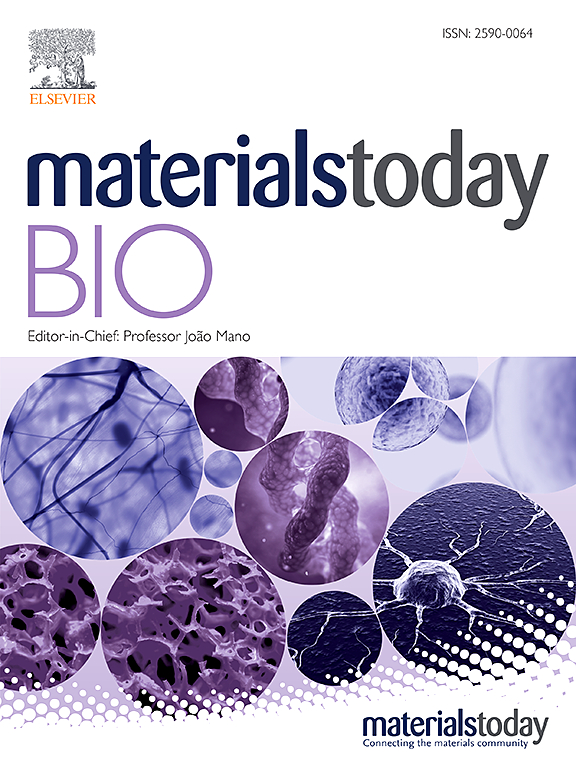铜绿微球通过 Wnt/β-catenin 通路抑制骨关节炎中的杯突症和氧化应激
IF 8.7
1区 医学
Q1 ENGINEERING, BIOMEDICAL
引用次数: 0
摘要
本研究旨在评估铜氧化物微球对骨关节炎(OA)的治疗潜力,特别是研究其潜在的分子机制。该微球由 Ca(NO3)2-4H2O、Cu(NO3)2-3H2O 和硅胶制成,并在体外对经白细胞介素-1β(IL-1β)处理以模拟 OA 的小鼠原代软骨细胞进行了进一步的治疗效果测试,在体内对通过前十字韧带横断(ACLT)手术诱发的 OA 小鼠进行了进一步的治疗效果测试。结果表明,微球可减轻IL-1β诱导的细胞凋亡、炎症、氧化应激和杯突变标志物,同时增强软骨细胞的细胞活力和细胞外基质(ECM)成分。此外,微球还能改善 OA 小鼠的组织病理学损伤,减少炎症、氧化应激和杯突症标志物,提高 ECM 生物标志物水平,这表明微球在抑制杯突症和氧化应激方面发挥了作用。使用 Wnt/β-catenin 通路激动剂 SKL2001 证实了铜绿微球的上述作用。研究结果表明,铜绿微球是治疗 OA 和软骨再生的一种很有前景的干预措施,突出了其在细胞和分子水平上的治疗效果。本文章由计算机程序翻译,如有差异,请以英文原文为准。

Cuprorivaite microspheres inhibit cuproptosis and oxidative stress in osteoarthritis via Wnt/β-catenin pathway
This study aims to evaluate the therapeutic potential of cuprorivaite microspheres for osteoarthritis (OA), in particular, potential molecular mechanisms were investigated. The microspheres were developed from Ca(NO3)2•4H2O, Cu(NO3)2•3H2O, and silica gel, and further therapeutic effects were tested in vitro on mouse primary chondrocytes treated with interleukin-1β (IL-1β) to mimic OA, and in vivo on OA mice induced via anterior cruciate ligament transection (ACLT) surgery. The microspheres were shown to mitigate IL-1β-induced apoptotic, inflammatory, oxidative stress and cuproptosis markers while enhancing cell viability and extracellular matrix (ECM) components in chondrocytes. Moreover, the microspheres ameliorated histopathological damage, reduced inflammatory, oxidative stress and cuproptosis markers, and enhanced ECM biomarker levels in OA mice, implicating their role in suppressing cuproptosis and oxidative stress. The aforementioned effects of the cuprorivaite microspheres were demonstrated by using SKL2001, an agonist of the Wnt/β-catenin pathway. The results suggest cuprorivaite microspheres as a promising intervention for OA and cartilage regeneration, highlighting their therapeutic effects on cellular and molecular levels.
求助全文
通过发布文献求助,成功后即可免费获取论文全文。
去求助
来源期刊

Materials Today Bio
Multiple-
CiteScore
8.30
自引率
4.90%
发文量
303
审稿时长
30 days
期刊介绍:
Materials Today Bio is a multidisciplinary journal that specializes in the intersection between biology and materials science, chemistry, physics, engineering, and medicine. It covers various aspects such as the design and assembly of new structures, their interaction with biological systems, functionalization, bioimaging, therapies, and diagnostics in healthcare. The journal aims to showcase the most significant advancements and discoveries in this field. As part of the Materials Today family, Materials Today Bio provides rigorous peer review, quick decision-making, and high visibility for authors. It is indexed in Scopus, PubMed Central, Emerging Sources, Citation Index (ESCI), and Directory of Open Access Journals (DOAJ).
 求助内容:
求助内容: 应助结果提醒方式:
应助结果提醒方式:


